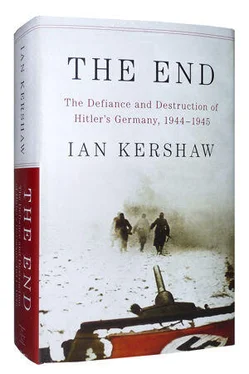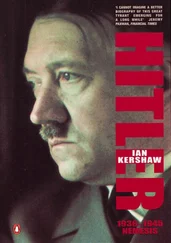154. For a similar point made about 1918, see Michael Geyer, ‘ Endkampf 1918 and 1945: German Nationalism, Annihilation, and Self-Destruction’, in Alf Lüdtke and Bernd Weisbrod (eds.), No Man’s Land of Violence: Extreme Wars in the 20th Century , Göttingen, 2006, pp. 90–91.
CONCLUSION: ANATOMY OF SELF-DESTRUCTION
1. A point well made by Bernd Wegner, ‘The Ideology of Self-Destruction: Hitler and the Choreography of Defeat’, Bulletin of the German Historical Institute London , 26/2 (2004), pp. 19–20. See also Wegner’s reflections in DRZW , 8, pp. 1185–91.
2. Hans Rothfels, The German Opposition to Hitler , pb. edn., London, 1970, p. 146, was adamant ‘that Casablanca destroyed any hope of a tolerable peace which might still have been entertained by the German Resistance movement’. Adam von Trott tried in June 1944 to persuade the western Allies to drop the demand, arguing that many in the opposition felt they could not risk an internal rising otherwise. In the event, of course, they did precisely this, despite the demand. Whether in fact the demand for unconditional surrender had any significant impact on the resistance movement remains nevertheless unclear.—Anne Armstrong, Unconditional Surrender: The Impact of the Casablanca Policy upon World War Two , New Brunswick, NJ, 1961, pp. 205, 212–13.
3. See DRZW , 6 (Boog), p. 85; also Reimer Hansen, Das Ende des Dritten Reiches: Die deutsche Kapitulation 1945 , Stuttgart, 1966, pp. 20–23, 36–9, 224–5; and Reimer Hansen, Der 8. Mai 1945: Geschichte und geschichtliche Bedeutung , Berlin, 1985, pp. 10–13, 22–3.
4. To mitigate the possibility of their demand for ‘unconditional surrender’ stimulating resistance, both Churchill and Roosevelt sought in public statements to reassure the German people that the stipulation did not mean that they would be ‘enslaved or destroyed’.—Winston S. Churchill, The Second World War , vol. 4: The Hinge of Fate , London, 1951, pp. 616–18.
5. MadR , 17, p. 6734 (late March 1945).
6. See the comments of Rolf-Dieter Müller in DRZW , 10/2, pp. 705, 716.
7. See Bernhard R. Kroener, ‘Auf dem Weg zu einer “nationalsozialistischen Volksarmee”: Die soziale Öffnung des Heeresoffizierkorps im Zweiten Weltkrieg’, in Martin Broszat, Klaus-Dietmar Henke and Hans Woller (eds.), Von Stalingrad zur Währungsreform: Zur Sozialgeschichte des Umbruchs in Deutschland , Munich, 1988, pp. 653, 658–9, 671–3, 676–7; and MacGregor Knox, ‘1 October 1942: Adolf Hitler, Wehrmacht Officer Policy, and Social Revolution’, Historical Journal , 43 (2000), pp. 801–25 (figures on size of the officer corps, p. 810).
8. Klaus-Jürgen Müller, ‘The Wehrmacht: Western Front’, in David Wingeate Pike (ed.), The Closing of the Second World War: Twilight of a Totalitarianism , New York, 2001, pp. 55–6.
9. See the reflections on ‘duty’, a leitmotiv of the book, in John Zimmermann, Pflicht zum Untergang: Die deutsche Kriegführung im Westen des Reiches 1944/45 , Paderborn, 2009, pp. 469–70.
10. Sönke Neitzel, Abgehört: Deutsche Generäle in britischer Kriegsgefangenschaft 1942–1945 , Berlin, 2005.
11. Albert Speer, Erinnerungen , Frankfurt am Main and Berlin, 1969, p. 434.
12. In his testimony at Nuremberg, Speer had explicitly ruled out the possibility of any group being able to confront Hitler with a demand to end the war.— IMT , vol. 16, p. 542. Rolf-Dieter Müller, ‘Speers Rüstungspolitik im Totalen Krieg’, Militärgeschichtliche Zeitschrift , 59 (2000), p. 362, points out that, although all Hitler’s subordinate leaders played at one time or another with the aim of finding a way out of the war other than total defeat and destruction, there was, in contrast to Italy, no body which could take action against the Dictator. Speer, he adds, ‘evidently at no point thought of acting against his mentor’.
List of Archival Sources Cited
Bayerisches Hauptstaatsarchiv, Munich: MInn 72417; Reichsstatthalter 257, 389/4, 644/2, 681/1–8, 686/1, 699, 482/1, 498, 527–8; MA 106695–6.
BBC Archives, London: interviews from the BBC-2 series The Nazis: A Warning from History (1997).
Bibliothek für Zeitgeschichte, Stuttgart: Sammlung Sterz—Feldpostbriefe.
Bundesarchiv, Berlin/Lichterfelde: Parteikanzlei der NSDAP, NS6/51, 134–7, 153, 166–7, 169, 277, 353–4, 374, 756, 791–2; Persönlicher Stab Reichsführer-SS, NS19/424, 606, 612, 751, 772, 1022, 1029, 1318, 1793, 1858, 1862, 1864, 2068, 2409, 2454, 2606, 2721, 2864, 2903, 2936, 3034, 3118, 3121, 3271, 3320, 3337, 3652, 3705, 3809, 3833, 3910–12, 3931, 4015–17, Reichskanzlei, R43II/393a, 583a, 648a, 650c, 651d, 664a, 667b, 680a, 684, 692, 692a–b, 1648; Reichspostministerium, R4701 alt R48/11; Reichsministerium für Rüstung und Kriegsproduktion, R3/1511, 1522, 1526, 1528–9, 1531–3, 1535–45, 1583, 1618, 1620–23, 1623a, 1624–6, 1661, 1740; Reichsministerium für Volksaufklärung und Propaganda, R55/601, 603, 608, 610, 612, 620, 793, 21504.
Bundesarchiv/Militärarchiv, Freiburg: Materialsammlung: MSg2/2696–7, 5284; Nachlässe: N6/4, N24/39, N54/8, N60/17–18, 73–4, N245/2–3, 15, N265/26, 108, 112, 118, N374/8, N574/19, 22, N647/12–13, N648/1, N712/15; Heeresgruppen: RH2/319, 2682, 2684–5, RH19/II/204, 213, RH19/III/17, 667, 727, RH19/IV/141, 228, 250, RH20/4/593, 617, RH20/19/196, 245, RH21/3/420, 730, RH21/5/66; Seekriegsleitung: RM7/851, 854; OKW: RW4/57, 494, 881. RW44I/33, 54.
Imperial War Museum, Duxford: EDS [Enemy Documents Section], Collection of Captured German Documents; FO645, Nuremberg Interrogation Files; FIAT interrogation reports on Albert Speer and senior members of his ministry; Memoirs of P. E. von Stemann.
Institut für Zeitgeschichte, Munich: ED 195 (Slg. Schottenheim); Fa-91/2–5 (Parteikanzlei); Fa-93 (Pers. Stab/RFSS); Nbg.-Dok., NS-3501, PS-1787, PS-3683; ZS 145 (Schwerin von Krosigk), 597 (Grohé), 988 (Kritzinger), 1810 (Dönitz), 1953 (Dankwort).
International Tracing Service, Bad Arolsen: Collection Todesmärsche: Tote, Boxes 1–83; Collection Evacuations: Evak 1–9; HNa 68.
Irving Collection: Selected Research Documents Relating to Hermann Göring, Reel 1 (microfilm from Microform Imaging Ltd., East Ardsley, Wakefield).
Liddell Hart Centre for Military Archives, King’s College, London: Dempsey Papers, nos. 72–336.
National Archives, London: Foreign Office: FO898/187; War Office: WO204/ 6384; WO208/4363–5, 5543, 5622; WO219/1587, 4713.
Staatsarchiv Augsburg: Gau Schwaben 1/28–37; Kreisleitung Augsburg-Stadt 1/8, 47, 65, 132; Ortsgruppe Wollmarkt 11/5; Kreisleitung Günzburg 1/42–3, 46–7, 55.
Staatsarchiv München: Gauleitung München, NSDAP 35, 52, 466a, 495, 499; Landratsamt Berchtesgaden, LRA 29656, 29715, 29718, 29728, 31391, 31645, 31908, 31919, 31921, 31936, 156108; Staatsanwaltschaften 6751, 18848/2–3, 34876/25.
1945: Das Jahr der endgültigen Niederlage der faschistischen Wehrmacht. Dokumente , ed. Gerhard Förster and Richard Lakowski, Berlin, 1975.
Addison, Paul, and Crang, Jeremy A. (eds.), Firestorm: The Bombing of Dresden, 1945 , London, 2006.
von Ahlfen, Hans, and Niehoff, Hermann, So kämpfte Breslau: Verteidigung und Untergang von Schlesiens Hauptstadt , Munich, 1959.
Akten der Partei-Kanzlei der NSDAP , vol. 1, ed. Helmut Heiber, Munich, 1983; vol. 2, ed. Peter Longerich, Munich, 1989.
Albrecht, Dieter, ‘Regensburg in der NS-Zeit’, in Dieter Albrecht (ed.), Zwei Jahrtausende Regensburg , Regensburg, 1979.
Читать дальше












